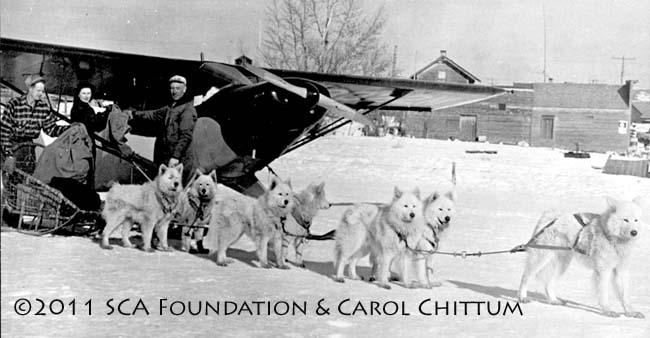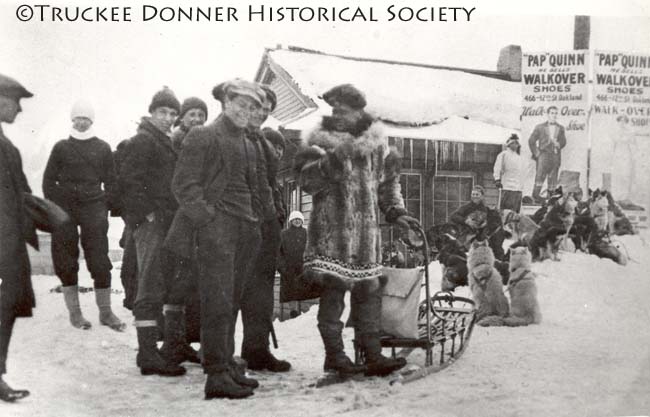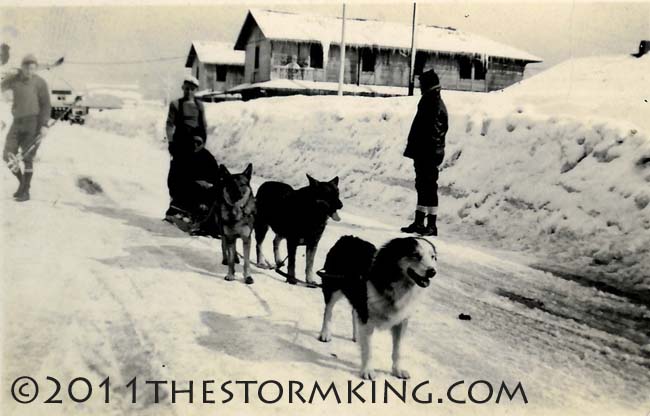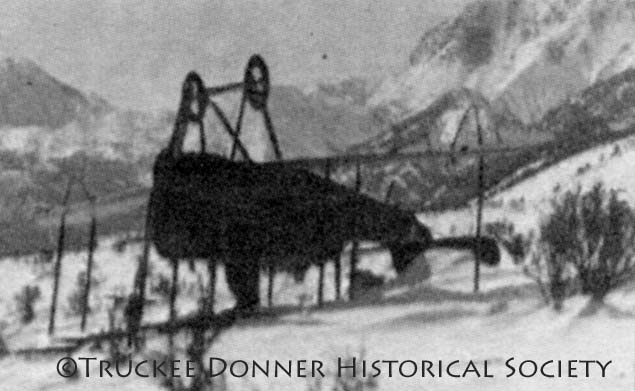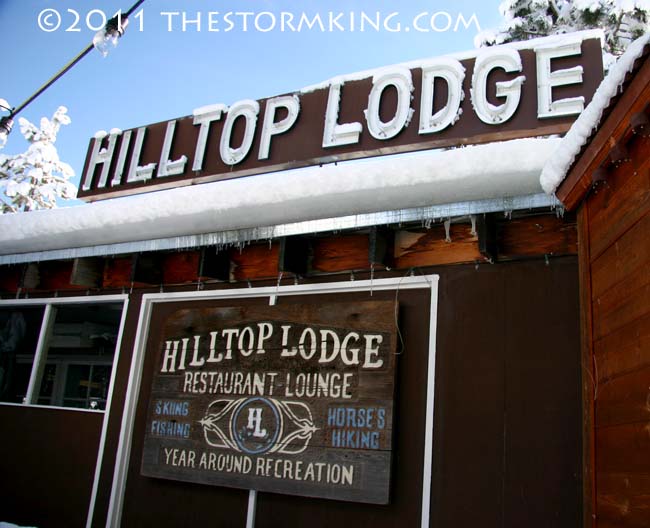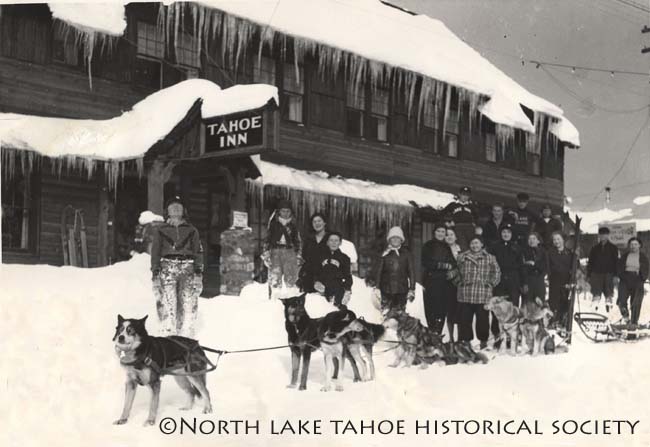 |
|
|
Follow Mark on Facebook for more stories |
||
 |
|||||
|
Tahoe Nugget #197: Rex the Blizzard King (Part 1) I recently published this story in two parts for one of my Tahoe magazine columns. I received strong positive feedback on it so I decided to share it here on the Tahoe Nugget list. Rex is the lead dog in photo #1. Rex is probably the most famous dog you never heard of. Rex of White Way was a superhero Samoyed canine known for more than 30 mountain rescues over his lifetime, including an impressive effort delivering a Truckee doctor to a snowbound train west of Donner Pass in January 1952. His exceptional endurance and uncanny ability to forge ahead on his stormy missions despite billowing drifts and blinding snow earned him the moniker — Rex, "The Blizzard King."
Rex was the epitome of the Samoyed, a breed valued for the ability to function as capable working dogs in meaningful and productive labor. First bred by Arctic communities nearly 3,000 years ago, Samoyeds were used to pull sledges, serve as guard dogs and herd reindeer. The name came from the Samoyed tribe of people from the north or Russia and Siberia. It is one of the oldest canine breeds on Earth and well adapted to working in partnership with humans. Initially it didn't look like Rex was going to have an exceptional life at all. A few months after he was born at the Sacramento, California, White Way Kennels in 1946, owners Agnes Mason and daughter Aljean took one look at the puppy and figured that he couldn't be a candidate for their champion breeding program. According to the contemporary breeding standards, Rex was too tall, his thick coat too short, and his legs too gangly. Agnes almost considered Rex an embarrassment to her well-respected kennel, but over time he became the top male of all American-born Samoyeds through his breedings and offspring. During the course of his life Rex excelled in so many ways that he became famous and the "new standard" for the breed. The height standard for male Samoyeds was raised 1.5 inches, and now, 54 years after his death in 1957, the vast majority of Samoyeds in the United States can be traced genetically to Rex of White Way.
Rex wasn't a big dog, but he had heart, keen intelligence, speed, and world class strength. Among his many exploits Rex set a world record in weight pulling for a pure bred dog, worked on a movie set with actor John Wayne, rescued crash victims from Truckee's airfield, and won countless sled races. As an adult Rex weighed from 62 to 70 pounds; he was exceptionally fit and had the perfect temperament to lead dogs in harness. Rex led with a bearing, strength and calmness that other team dogs recognized and respected, which minimized fights. In one practice run, trainer Lloyd Van Sickle had Rex at lead with 60 dogs hitched behind him. What made Rex go? One observer said, "Rex was five pounds of bones and hair, the rest was all heart." Rex's long and storied career in wintertime rescue operations is legend, but search and rescue training was almost a tradition at the Mason's White Way Kennels. During World War II, the Masons volunteered their Samoyeds for service in the U.S. Army and several dogs were trained to parachute from small aircraft to help out in remote rescue efforts. A sled with an attached parachute was dropped first from the plane, and then the dogs, one by one, each with a chute. Once on the ground, the dogs were gathered up and hitched to the sled. The military exercises demonstrated the adaptability and trainability of the Samoyed, but criticism from the Samoyed Club of America forced Ms. Mason to eventually discontinue the program. It's likely that Rex received similar parachute jump training, but no one knows for sure.
Lloyd Van Sickel, the Idaho-born chief trainer at White Way Kennels, believed that Samoyeds were natural work dogs and far easier to break in to sled and stunt work than other breeds. Besides his work for the Mason's kennel, Van Sickel owned a ranch for training and boarding dogs. Over the years, he provided dogs for the film industry, including John Wayne's "Island in the Sky," and TV programs such as "Have Gun Will Travel" and "Bonanza."
Van Sickel personally took charge of Rex's training in the spring of 1947 and later moved to Truckee to get involved in sled dog racing. Sled racing had enjoyed popularity during the early twentieth century Winter Carnivals at Truckee, but World War II had disrupted the contests along with many other winter sports activities. By the winter of 1949, however, the Donner Trail Association was sponsoring a team of racing dogs and challenging drivers of teams in Truckee (Mason-Van Sickel) and Tahoe City (Constable Harry Johanson). Mrs. Mason had her 11 Samoyeds kenneled at the Hill Top Lodge above Truckee, along with a team of Irish Setters owned by Van Sickle.
Lloyd Van Sickle and his dogs soon became part of Truckee's local color and from winter's first snow could be seen daily, mushing along the town's icy streets. In March 1949, Van Sickle became the U.S. champion of 11-mile dog sled racing when his team, led by Rex, took first place in a national competition held near Truckee. Two months later, Van Sickle and Rex successfully defended their national crown in the Sierra Dog Derby in front of an estimated 1,000 spectators, beating out Lloyd's brother Bob, who was visiting from Idaho with a team of Malamutes.
Van Sickle's location in Truckee made him the "go to guy" when it came to mountain rescues during the winter months. Engine-powered snow cats and functional snowmobiles were still in early development and unavailable; dog sleds were the only way to get supplies in or victims out of the snowbound backcountry. (Tahoe City Constable Harry Johanson had been using his own dog teams for search and rescue in the Lake Tahoe area.) In 1949 alone Rex was involved in several rescue operations, and over the next few years he was credited as the sled leader to at least three airplane crashes at Truckee's airfield where pilots and passengers were rescued. Special thanks to author Jim Cheskawich and film director Michael Kanyon who intend to produce a documentary and book based on the accomplishments of Rex, "The Blizzard King." |
|||||
|

